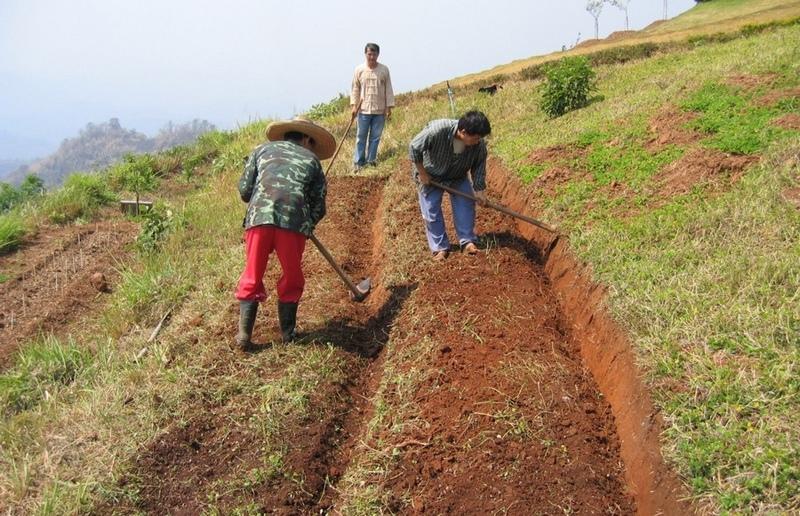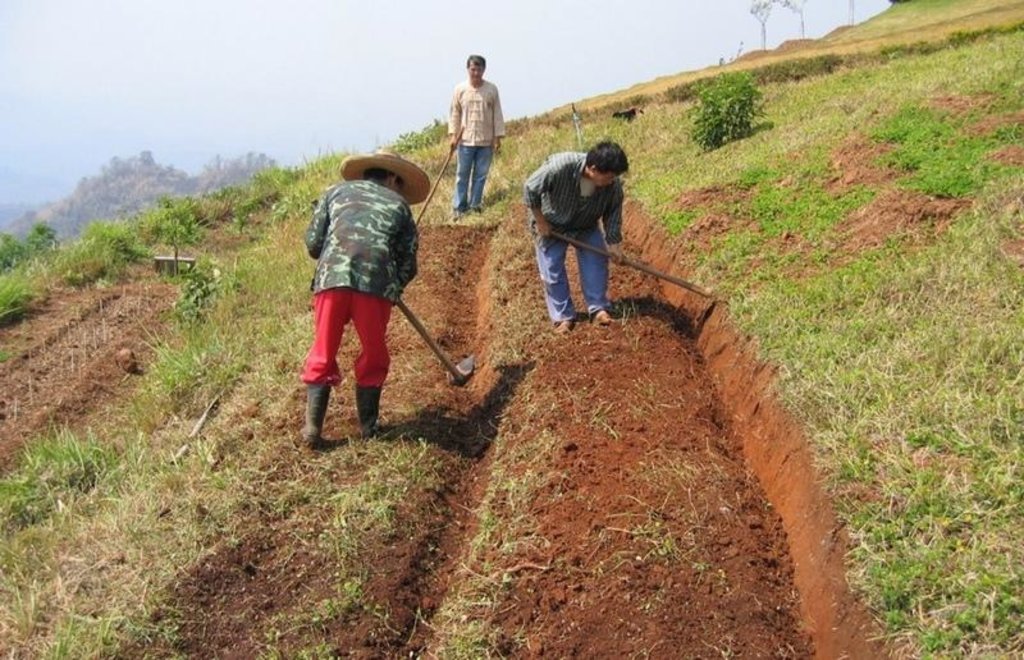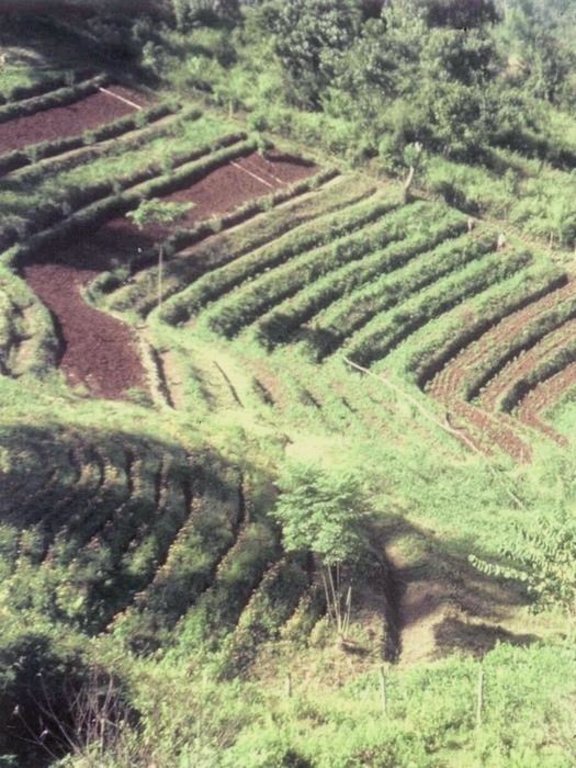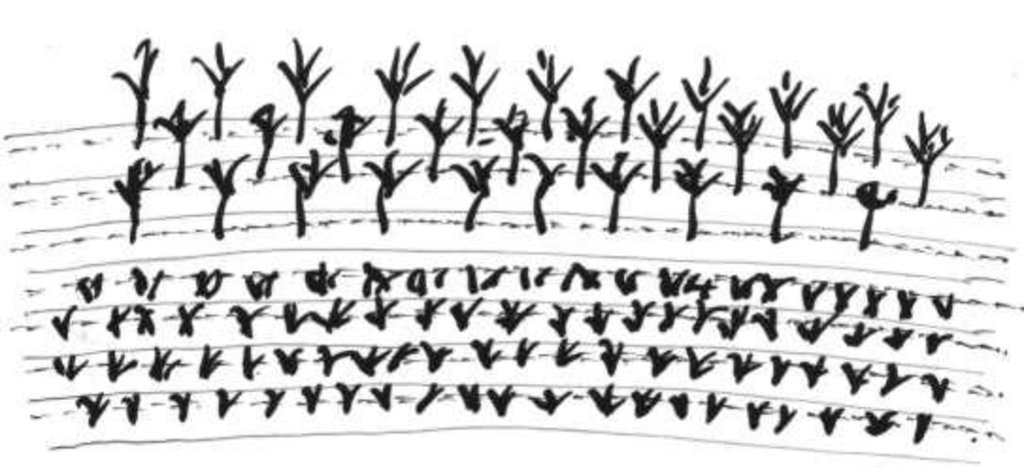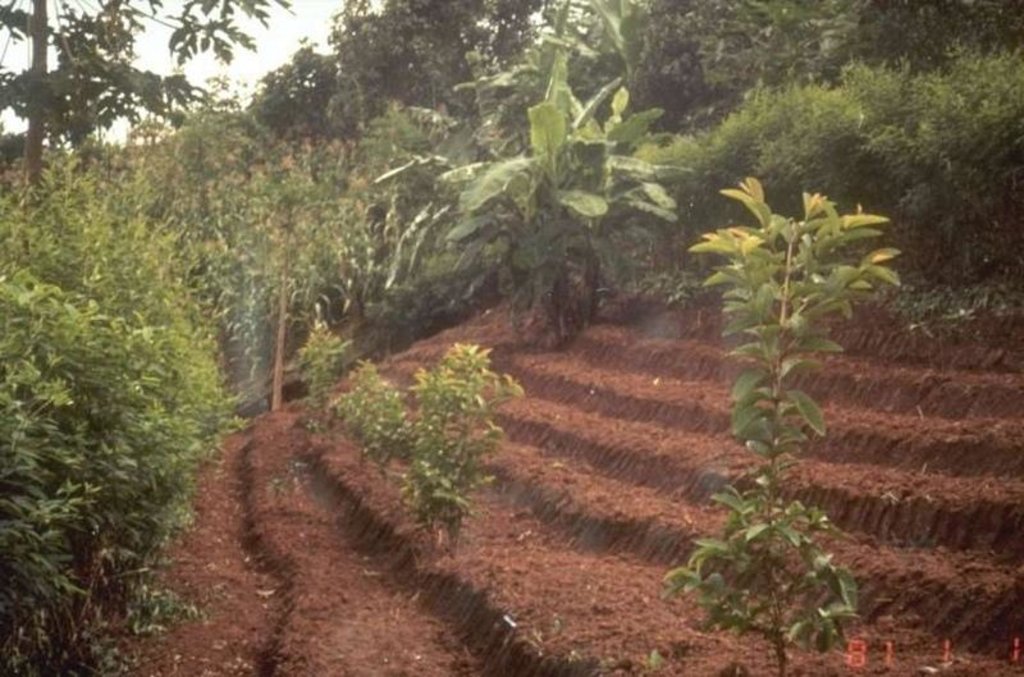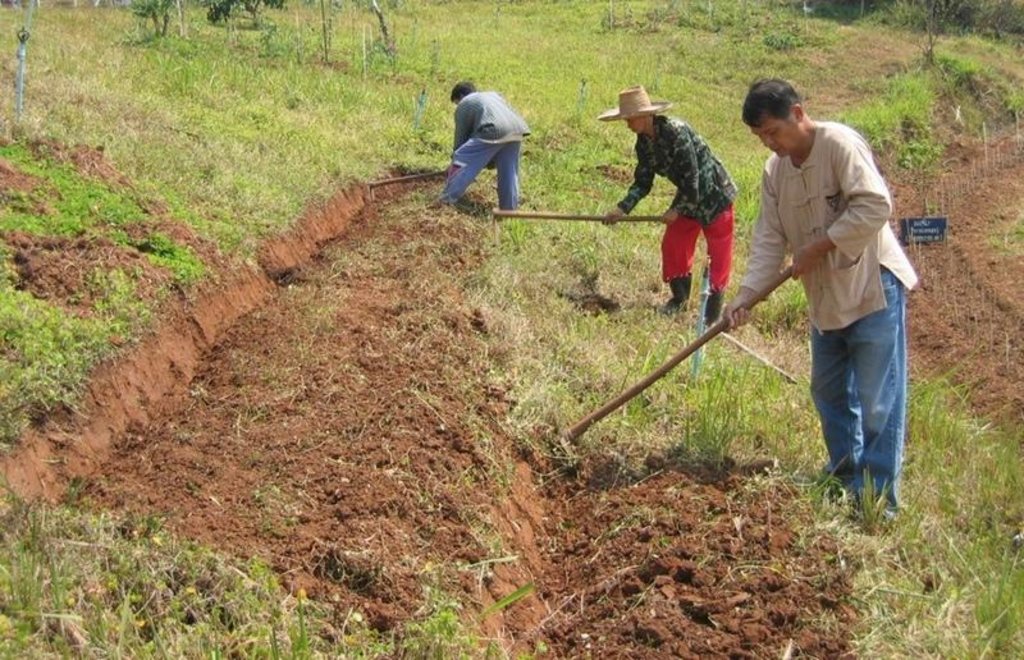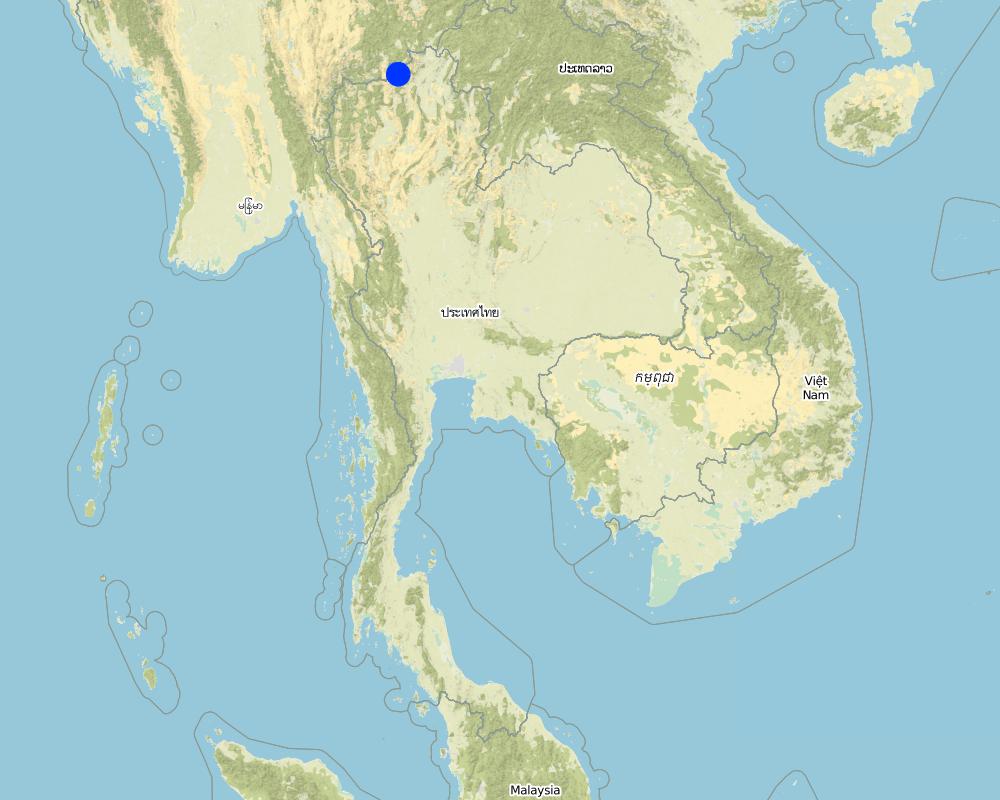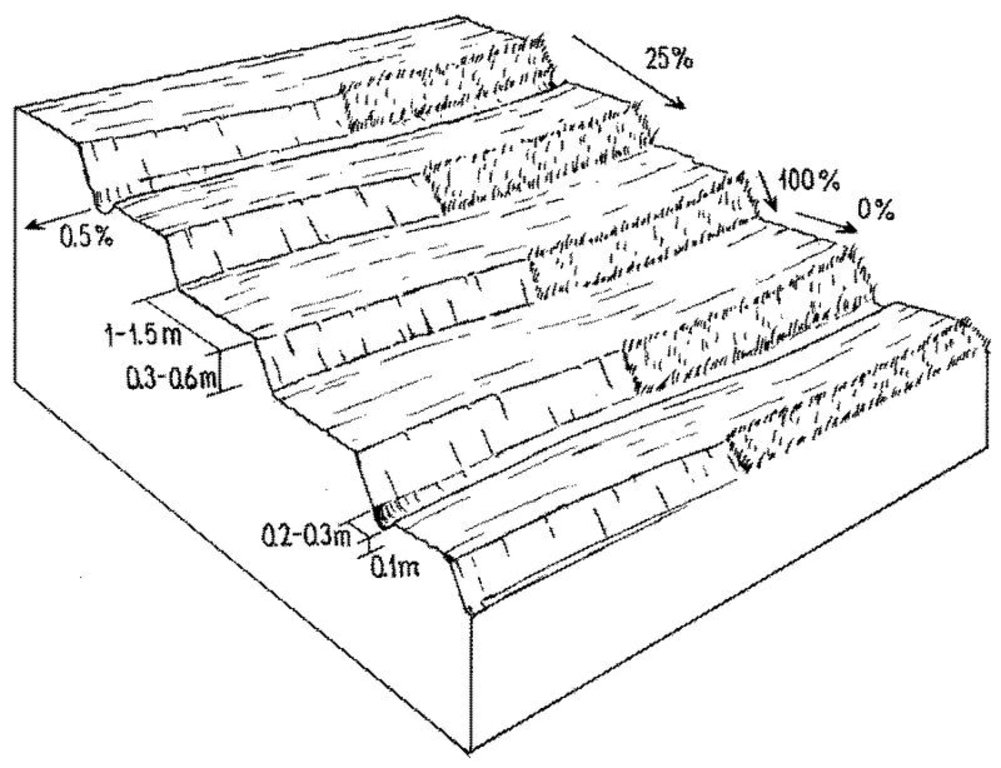Small level bench terraces [泰国]
- 创建:
- 更新:
- 编制者: Samran Sombatpanit
- 编辑者: –
- 审查者: Fabian Ottiger, Alexandra Gavilano
Khan ban dai din khanard lek (Thai)
technologies_1404 - 泰国
查看章节
全部展开 全部收起1. 一般信息
1.2 参与该技术评估和文件编制的资源人员和机构的联系方式
SLM专业人员:
Cheewinkuntong Wichai
泰国
有助于对技术进行记录/评估的项目名称(如相关)
Book project: where the land is greener - Case Studies and Analysis of Soil and Water Conservation Initiatives Worldwide (where the land is greener)有助于对技术进行记录/评估的机构名称(如相关)
World Association of Soil and Water Conservation (WASWC) - 中国1.3 关于使用通过WOCAT记录的数据的条件
编制者和关键资源人员接受有关使用通过WOCAT记录数据的条件。:
是
2. SLM技术的说明
2.1 技术简介
技术定义:
Terraces with narrow beds, used for growing tea, coffee, and horticultural crops on hillsides cleared from forests.
2.2 技术的详细说明
说明:
The terraces described in this case study from northern Thailand are found on hilly slopes with deep soils. The climate is humid and tropical, with 1,700-2,000 mm of rainfall annually. The main aim of the terraces is to facilitate cultivation of tea or coffee on sloping land: erosion control is secondary. Coffee and tea, as well as flowers and vegetables, are good alternatives to opium poppies - which it is government policy to eradicate.
Purpose of the Technology: After clearing natural and secondary forests by slash and burn, terraces are aligned by eye - and constructed by hoe. The width of the bed is 1.0-1.5 m depending on slope, though there are no specific technical guidelines. The length of each terrace can be up to 25 m. Down the slope, after every 3-4 terraces, there are lateral drainage channels, approximately 20-30 cm wide and 10 cm deep. Situated at the foot of a riser, each channel has a gradient of 0.5% or less. Excess water - some of which cascades over the terrace risers, with some draining through the soil - is discharged through these channels, generally to natural waterways. The risers are steep, with a slope of above 100%, and without a defined lip.
Establishment / maintenance activities and inputs: Natural grass cover develops on the risers: this is cut back by hand hoe or machete, or completely removed. The grass is often burned. After harvest (of annual crops), the land is left until immediately before the next rainy season. The terraces at this stage are covered by weeds and grasses. Land is then tilled by hoe. The weeds and grasses are removed and heaped in piles outside the cropped area. They are not composted or used for mulching - and here an opportunity is missed. Where soil fertility is a problem, chemical fertilizers are used. Maintenance includes building up/repairing of risers and levelling of terrace beds as required.
Natural / human environment: The technology was pioneered, and continues to be practiced, by refugee immigrants from China looking for new areas to start farming. These immigrants first came in the 1950s, and cultivated simply through slash and burn techniques. During the 1970s they visited relatives in Taiwan and brought back the idea of small terraces. Originally they settled illegally, but eventually they were given official permission to stay. However, official title deeds to their land have not yet been allocated.
2.3 技术照片
2.5 已应用该技术的、本评估所涵盖的国家/地区/地点
国家:
泰国
区域/州/省:
ChiangMai
有关地点的进一步说明:
Amphur Mae Fa Luang
具体说明该技术的分布:
- 均匀地分布在一个区域
如果不知道精确的区域,请注明大致覆盖的区域:
- 1-10 平方千米
注释:
Total area covered by the SLM Technology is 5 km2.
This practice has been done by tribal people such as E-kaw, Lahu, Lisu, Mien, Khin, Thai Yai, Haw Chinese, H'mong
Map
×2.6 实施日期
如果不知道确切的年份,请说明大概的日期:
- 不到10年前(最近)
2.7 技术介绍
详细说明该技术是如何引入的:
- 通过土地使用者的创新
注释(项目类型等):
Taiwan.
3. SLM技术的分类
3.1 该技术的主要目的
- 改良生产
- 减少、预防、恢复土地退化
- 创造有益的经济影响
3.2 应用该技术的当前土地利用类型

农田
- 一年一作
- 多年一作(非木材)
- 乔木与灌木的种植
- vegetables, flowers
乔木和灌木种植 - 指定作物:
- 咖啡,露天种植
- 茶叶
每年的生长季节数:
- 2
具体说明:
Longest growing period in days: 150 Longest growing period from month to month: Dec - Apr
注释:
Major land use problems (compiler’s opinion): - soil erosion on cultivated hillsides
- practical difficulties in tending tea, coffee, vegetables and flowers on sloping land: farming is much easier on levelled land
- Lacking of land ownership (The whole area is reserved forest.)
- Low price of agricultural produce.
Major land use problems (land users’ perception): 1. Lacking of land ownership. 2. Landusers do not have Thai citizenship; less than 20% have ID cards (not citizenship).
Forest: before SWC measures
3.4 供水
该技术所应用土地的供水:
- 雨养
3.5 该技术所属的SLM组
- 横坡措施
- 引水和排水
3.6 包含该技术的可持续土地管理措施

植物措施
- V2:草和多年生草本植物

结构措施
- S1:阶地
注释:
Main measures: structural measures
Secondary measures: vegetative measures
3.7 该技术强调的主要土地退化类型

土壤水蚀
- Wt:表土流失/地表侵蚀

化学性土壤退化
- Cn:肥力下降和有机质含量下降(非侵蚀所致)

水质恶化
- Ha:干旱化
注释:
Main type of degradation addressed: Wt: loss of topsoil / surface erosion, Cn: fertility decline and reduced organic matter content, Ha: aridification
Main causes of degradation: deforestation / removal of natural vegetation (incl. forest fires), Lack of enforcement of legislation or authority
Secondary causes of degradation: other human induced causes (specify) (Agricultural activities), other natural causes (avalanches, volcanic eruptions, mud flows, highly susceptible natural resources, extreme topography, etc.) specify
3.8 防止、减少或恢复土地退化
具体数量名该技术与土地退化有关的目标:
- 防止土地退化
4. 技术规范、实施活动、投入和成本
4.1 该技术的技术图纸
技术规范(与技术图纸相关):
Layout of small level bench terraces. After every third or fourth terrace a lateral drainage channel is built. Later, protective grass cover is established on the risers (right).
Technical knowledge required for field staff / advisors: moderate
Technical knowledge required for land users: moderate
Main technical functions: control of dispersed runoff: retain / trap, reduction of slope angle, reduction of slope length
Secondary technical functions: control of concentrated runoff: impede / retard, increase of infiltration, increase / maintain water stored in soil
Vegetative measure: grass on risers (optional)
Vegetative material: G : grass
Vegetative measure: Vegetative material: G : grass
Vegetative measure: Vegetative material: G : grass
Vegetative measure: Vegetative material: G : grass
Terrace: bench level
Vertical interval between structures (m): 0.4
Spacing between structures (m): 0.3
Height of bunds/banks/others (m): 0.4
Width of bunds/banks/others (m): 1.5
Length of bunds/banks/others (m): 25
Structural measure: drainage channels
Depth of ditches/pits/dams (m): 0.1
Width of ditches/pits/dams (m): .02 - .3
Construction material (earth): It is the earth dug in situ.
Lateral gradient along the structure: 0%
Vegetation is used for stabilisation of structures.
作者:
Mats Gurtner
4.2 有关投入和成本计算的一般信息
其它/国家货币(具体说明):
Baht
如相关,注明美元与当地货币的汇率(例如1美元=79.9巴西雷亚尔):1美元=:
37.0
注明雇用劳工的每日平均工资成本:
2.16
4.3 技术建立活动
| 活动 | 时间(季度) | |
|---|---|---|
| 1. | Layout is simply by eye and best judgment. | |
| 2. | Work begins on the lower part of the slope, and then progresses uphill. | |
| 3. | Farmers cut into the hillside with hoes and drag the soil down to formthe risers and level the terrace beds. | |
| 4. | Risers are then stabilised/compacted by hoe. |
4.4 技术建立所需要的费用和投入
| 对投入进行具体说明 | 单位 | 数量 | 单位成本 | 每项投入的总成本 | 土地使用者承担的成本% | |
|---|---|---|---|---|---|---|
| 劳动力 | Labour | ha | 1.0 | 270.0 | 270.0 | 100.0 |
| 设备 | Tools | ha | 1.0 | 5.0 | 5.0 | 100.0 |
| 技术建立所需总成本 | 275.0 | |||||
| 技术建立总成本,美元 | 7.43 | |||||
注释:
Duration of establishment phase: 12 month(s)
4.5 维护/经常性活动
| 活动 | 时间/频率 | |
|---|---|---|
| 1. | Weeds and grasses are removed and piled outside the cropping area. | |
| 2. | Land is prepared through tillage by hoe. | |
| 3. | Risers are built up/repaired where necessary. | |
| 4. | Terrace beds may need levelling. |
4.6 维护/经常性活动所需要的费用和投入(每年)
| 对投入进行具体说明 | 单位 | 数量 | 单位成本 | 每项投入的总成本 | 土地使用者承担的成本% | |
|---|---|---|---|---|---|---|
| 劳动力 | Labour | ha | 1.0 | 45.0 | 45.0 | 100.0 |
| 设备 | Tools | ha | 1.0 | 45.0 | 45.0 | 100.0 |
| 技术维护所需总成本 | 90.0 | |||||
| 技术维护总成本,美元 | 2.43 | |||||
注释:
Clearing of forest is not included in the cost calculations. This calculation is based on a typical slope of approximately 20%, with risers of 0.2 m in height and beds 1.0 m wide. Maintenance costs include basic land preparation (for annual crops) or weeding etc for perennial crops.
4.7 影响成本的最重要因素
描述影响成本的最决定性因素:
The slope factor affects most because it will require longer time to construct.
5. 自然和人文环境
5.1 气候
年降雨量
- < 250毫米
- 251-500毫米
- 501-750毫米
- 751-1,000毫米
- 1,001-1,500毫米
- 1,501-2,000毫米
- 2,001-3,000毫米
- 3,001-4,000毫米
- > 4,000毫米
有关降雨的规范/注释:
Average 1600-1800 mm
农业气候带
- 潮湿的
Thermal climate class: tropics
5.2 地形
平均坡度:
- 水平(0-2%)
- 缓降(3-5%)
- 平缓(6-10%)
- 滚坡(11-15%)
- 崎岖(16-30%)
- 陡峭(31-60%)
- 非常陡峭(>60%)
地形:
- 高原/平原
- 山脊
- 山坡
- 山地斜坡
- 麓坡
- 谷底
垂直分布带:
- 0-100 m a.s.l.
- 101-500 m a.s.l.
- 501-1,000 m a.s.l.
- 1,001-1,500 m a.s.l.
- 1,501-2,000 m a.s.l.
- 2,001-2,500 m a.s.l.
- 2,501-3,000 m a.s.l.
- 3,001-4,000 m a.s.l.
- > 4,000 m a.s.l.
关于地形的注释和进一步规范:
Slopes on average: Also steep (ranked 3)
Soil fertility: Low (ranked 1) and very low (ranked 2)
Soil drainage/infiltration: Medium (ranked 1, good drainage though being cleyey soil) and good (ranked 2)
Soil water storage capacity: Medium and low (both ranked 1)
5.3 土壤
平均土层深度:
- 非常浅(0-20厘米)
- 浅(21-50厘米)
- 中等深度(51-80厘米)
- 深(81-120厘米)
- 非常深(> 120厘米)
土壤质地(表土):
- 中粒(壤土、粉土)
表土有机质:
- 低(<1%)
5.6 应用该技术的土地使用者的特征
生产系统的市场定位:
- 生计(自给)
- 商业/市场
非农收入:
- 收入的10-50%
相对财富水平:
- 贫瘠
- 平均水平
机械化水平:
- 手工作业
- 畜力牵引
说明土地使用者的其他有关特征:
Population density: < 10 persons/km2
6% of the land users are rich and own 35% of the land.
24% of the land users are average wealthy and own 40% of the land.
60% of the land users are poor and own 20% of the land.
10% of the land users are poor and own 5% of the land.
Off-farm income specification: farmers spend much time as farm labourers on other farms or in food processing factories - and some have jobs at construction sites, for example road building
Level of mechanization: Manual work (ranked 1) and animal traction (ranked 2)
Market orientation: Commercial/market (ranked 1, tea, coffee, vegetable and flower production) and subsistence (ranked 2)
5.7 应用该技术的土地使用者使用的平均土地面积
- < 0.5 公顷
- 0.5-1 公顷
- 1-2 公顷
- 2-5公顷
- 5-15公顷
- 15-50公顷
- 50-100公顷
- 100-500公顷
- 500-1,000公顷
- 1,000-10,000公顷
- > 10,000公顷
注释:
Average area of land owned or leased by land users applying the Technology: Also 2-5 ha if farmers may farm at 2-4 plots far apart from each other.
5.8 土地所有权、土地使用权和水使用权
土地所有权:
- 州
土地使用权:
- 个人
- illegal (initially) (see Annex T3)
- illegal (initially) (see Annex T3)
6. 影响和结论性说明
6.1 该技术的现场影响
社会经济效应
生产
作物生产
注释/具体说明:
Production is not decreased.
生产区域
土地管理
收入和成本
农业收入
经济差异
工作量
注释/具体说明:
Ease of cultivation. Can walk and work in the farm easier
其它社会经济效应
Input constraints
社会文化影响
社区机构
国家机构
冲突缓解
生态影响
水循环/径流
地表径流
SLM之前的数量:
20
SLM之后的数量:
15
土壤
土壤水分
注释/具体说明:
During dry spells due to increased infiltration
土壤覆盖层
土壤流失
SLM之前的数量:
50
SLM之后的数量:
10
注释/具体说明:
Soil erosion is reduced
养分循环/补给
生物多样性:植被、动物
植物多样性
动物多样性
栖息地多样性
6.2 该技术的场外影响已经显现
旱季稳定可靠的水流
下游洪水
下游淤积
地下水/河流污染
风力搬运沉积物
6.4 成本效益分析
技术收益与技术建立成本相比如何(从土地使用者的角度看)?
短期回报:
稍微积极
长期回报:
积极
技术收益与技术维护成本/经常性成本相比如何(从土地使用者的角度看)?
短期回报:
稍微积极
长期回报:
积极
6.5 技术采用
如若可行,进行量化(住户数量和/或覆盖面积):
500
在所有采用这项技术的人当中,有多少人是自发的,即未获得任何物质奖励/付款?:
- 51-90%
注释:
10% of land user families have adopted the Technology with external material support
50 land user families have adopted the Technology with external material support
Comments on acceptance with external material support: estimates
90% of land user families have adopted the Technology without any external material support
450 land user families have adopted the Technology without any external material support
Comments on spontaneous adoption: estimates
There is a little trend towards spontaneous adoption of the Technology
Comments on adoption trend: There is a little growing spontaneous adoption: for example in the Mae Salong area farmers accept these terraces increasingly, but fruit growers tend to prefer intermittent ‘orchard terraces’ - terraces spaced apart, with 5 m or more of undisturbed land in-between. The benches in this case are backward sloping.
6.7 该技术的优点/长处/机会
| 土地使用者眼中的长处/优势/机会 |
|---|
| For facilitating picking of tea leaves |
| For using as farm path |
| For increasing soil fertility |
| 编制者或其他关键资源人员认为的长处/优势/机会 |
|---|
|
A relatively cheap method of terracing which makes cultivation easier and provides erosion control How can they be sustained / enhanced? Should be further promoted by extension agencies (in areas where cultivation is officially allowed). Allocation of official title deeds to land will speed up the adoption automatically. |
| For improving/maintaining soil fertility |
|
For increasing the yield of tea leaves How can they be sustained / enhanced? Inspecting the field during/after rain to see how efficient they are in conserving soil and water and repair as needed |
| For using as farm path |
| Compared with normal bench terraces, construction does not bring infertile subsoil to the surface. |
6.8 技术的弱点/缺点/风险及其克服方法
| 土地使用者认为的弱点/缺点/风险 | 如何克服它们? |
|---|---|
| Farmers have to pay for its construction. | The government may be able to help in the future. |
| 编制者或其他关键资源人员认为的弱点/缺点/风险 | 如何克服它们? |
|---|---|
| Does not lend itself to mechanisation: the terrace beds are narrow and only suited to hand hoeing. | Teach farmers techniques of composting and/or mulching. |
|
In this situation grasses and weeds are merely piled and burned rather than being used to improve soil fertility |
7. 参考和链接
7.1 信息的方法/来源
7.2 参考可用出版物
标题、作者、年份、ISBN:
No references
链接和模块
全部展开 全部收起链接
无链接
模块
无模块


